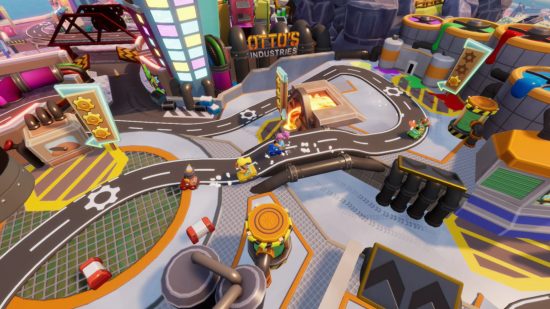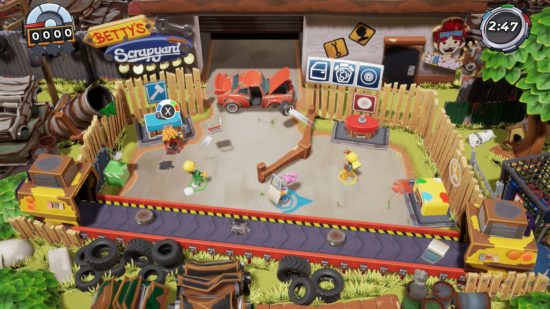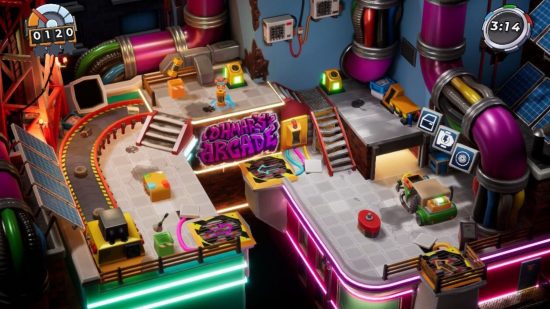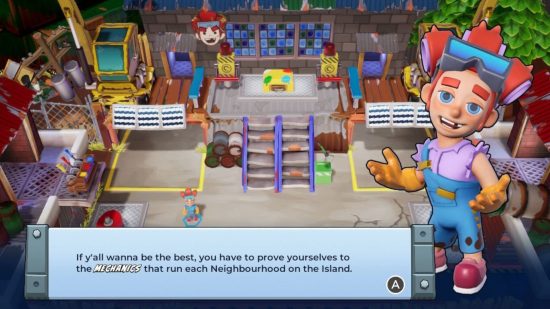There are few games these days that truly feel like they’re made for couch co-op. Still, when games do buck the trend, we tend to celebrate them for doing so – just take the critically lauded It Takes Two, for example. So, when 4J Studios offered Pocket Tactics a Manic Mechanics review, I jumped at the chance to see if the party game could rev the engines once more in an underappreciated genre.
The concept in Manic Mechanics is pretty simple. You take car parts like engines, wheels, and doors from a conveyor belt, fix them up using mechanic tools, and stick them on a car. That there is the core gameplay loop, with complications arising the further you progress through the levels as you come across new car parts, such as batteries and powered engines, and level layouts including hazards or falls. It’s very much Overcooked for petrolheads, but that isn’t a bad thing.
While things start out pretty tepid, after completing a few missions Manic Mechanics tunes up the challenge factor and offers some seriously engaging gameplay. With a five-minute timer on every level, there’s consistency across the board, and it’s just enough time to make the game feel fair even on some of the trickier levels.
You move between missions by means of hub worlds – little biomes where you can drive around and find the occasional secret. These hub worlds are pretty little locations that each contain five levels, with areas like Betty’s Scrapyard, Otto’s Industries, and Verne’s Aquapark, all full of color and character. While it’s not as riveting as the core gameplay, these mini-worlds add a certain something to the overall experience and bring the game world to life in a way that party games often struggle to achieve.

Visually, Manic Mechanics has a certain nostalgia that occasionally makes me feel like I’m playing something from the early noughties, but not necessarily in a negative way. The vivid color is reminiscent of the Crash Bandicoot trilogy or Crash Bash, with a vibrancy that rings true throughout the whole game. The characters are perhaps a touch too childlike for my liking, but they fit with the overall aesthetic, and it doesn’t take away much from the wider appeal.
Still, the true test of Manic Mechanics is how it feels in co-op mode, and it feels great. I passed my partner a controller, whizzed through the tutorial, and we had a grand old time recommissioning cars. Thanks to a three-star system, you can pass levels with just one star while still learning the mechanics before coming back to get full marks, and the difficulty curve throughout makes it so there’s always something new but not too daunting.
My main concern for the co-op mode was that, unlike party games from the Jackbox or Mario Party series, it is in a sense the same thing over and over again. Fortunately, the introduction of new car parts further into the story mode and a consistent theming across levels makes this very much not the case. In fact, after a solid hour or so of playing, I told my partner we could call it quits if she wanted as I had all the info I needed. She did not want to do that. She wanted to make more cars. That is a big ol’ box tick for the developers in my book.
Still, there are a couple of issues that put the brakes on my glowing review. My partner has clearly been reading my work, describing the in-level movement as ‘clunky at times’ – I’m welling up with pride here – and I have to agree. Especially on levels with hazards like Fan Service, sometimes your character runs into the corner next to the stairs, not the stairs, or you lose control in the chaos and your character plummets into the void in the middle of the stage. It’s not enough to put down the game, but it adds an element that occasionally feels unfair and detracts from the experience.
The boss levels also suffer slightly compared to the four regular levels in each hub world that build up to them. With the first boss, I found it sometimes feels unfair as Betty takes half-completed cars away while I put the finishing touches on the engine. Again, it’s not enough to put you off the game, but the regular levels are more engaging and consistent than the hit-or-miss end-of-world boss challenges.
It’s also fair to say that in the early sections, Manic Mechanics feels a bit derivative of other party games. Unique mechanics in the later levels makes this a thing of the past, but if the gameplay doesn’t grab you immediately, it might be a bit of a slog getting through the early section to find the more idiosyncratic components. If there is to be a sequel, I’d like to see something outside of the ‘oh, but it’s a car!’ concept that makes the game feel more its own and less of something that, on occasion, feels stitched together from other party game concepts.
In terms of Switch performance, there is a strange lag in the loading menu that makes you think things might not be great in the main game, but fortunately, this isn’t the case. The stutter only seems to appear in the menu, with brief moments of slowdown in the overworld, but the core gameplay is seemingly unaffected. There’s no issue with bringing in multiple mechanics either, with the game still running great while dealing with four players.
All-in-all, Manic Mechanics is an engaging party game that entices you with sharp visuals and gameplay that keeps you coming back for more. There is some space for improvement with boss battles and occasionally clunky controls, but if this is the start of a new series of party games, you can sign me up for more high-horsepower hijinks.
For more on the latest games, check out our Pikmin 1+2 review, Oxenfree II: Lost Signals review, and Master Detective Archives: Rain Code review.
Manic Mechanics review
With stellar multiplayer gameplay and an intelligently crafted difficulty curve, Manic Mechanics offers hours of engaging content to race through. While there is space to improve in terms of controls and boss battles, there’s enough here to add this one to your list of party night titles.















